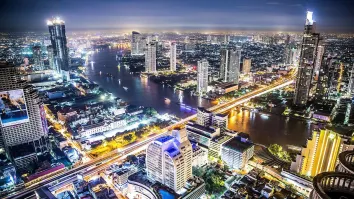Indian Banking: Rappelling down the NPA wall
By Saurabh BhaleraoDeteriorating asset quality led to enhanced provisioning, reduced profitability and a subdued capital position has created a challenging period for the Indian banking system. Poor asset quality levels also necessitated capital infusion into several banks, especially in the government owned banks. Policy measures like resolution under the Insolvency and Bankruptcy Code (IBC) has helped the banks in recoveries of certain bad accounts. The government has taken decisive measures towards consolidation of the banking sector by creating fewer banks of significant size which would be easier to operate and capitalize. Further, the government has announced infusion of capital to enable transition of these banks.
In India, banks dominate the credit market given the domestic bond market is under developed. Hence, the health of banks is a priority as they play a key role in financial intermediation. Further, a large majority of the banking space is owned by public sector banks (PSBs). The sector has been facing a large overhang of balance sheet stress. Post the asset quality review (AQR) of the banks prescribed by the Reserve Bank of India (RBI) (which is the central bank of India) led to recognition of bad assets on the balance sheet of the banks resulting in sharp deterioration in the non-performing assets (NPAs) of the banks and required banks to increase the provisioning for these bad loans. Due to this the gross NPAs of banks rose over four times from Rs. 2,320 bn in FY14 to Rs. 10,191 bn for FY18 (financial year refers to period from April 01 to March 31). In a similar manner, in FY18, Gross NPA to Gross Advances ratio shot up to 11.2% for the overall banking sector, 14.6% for PSBs, and 4.7% for private sector banks (PVBs). The industrial sector accounts for ~33% of advances, but has recorded ~75% of all NPAs. Asset quality deterioration in SCBs, especially PSBs, can be traced to the credit boom of 2006-2011 when lending grew at an average rate of over 20%. Other factors include lax post sanction monitoring, project delays/ cost overruns; absence of a strong bankruptcy regime, willful default/ frauds in some cases, and an economic slowdown.
In December, 2016, a landmark regulation titled Insolvency and Bankruptcy Code (IBC) which gave significant powers to the lenders to resolution of bad assets from banks was passed. Although, the resolution process has been slow due to teething problems with the new regulation, the overall credit culture among corporate borrowers has seen a change and banks have seen resolution in certain large NPAs.
There has been a robust recovery of Rs. 3,590 bn over the last four years, including recovery of Rs. 1,230 bn in FY19 by PSBs and resolution of a select set of large accounts. Additionally, slippages which had increased from 5.7% in FY17 to 7.6% in FY18 reduced in FY19 indicating slowing NPA, and write-offs. Consequently, during FY19 the incremental NPAs declined, leading to a reduction in Gross NPA to Gross Advances ratio to 9.3% for SCBs, 3.7% for PVBs and 12.6% for PSBs. PSBs have played a significant role in the India development story by lending to various large infrastructure projects. In the past few years, because of a variety of legacy issues, few large projects stalled or became non-viable and consequently lenders were also affected leading to an increase in NPAs. This rise in the level of NPAs has resulted in significant increase in provisioning requirement which has impacted profitability and increased capital requirement for growth as well as maintenance resulting in continuous need for recapitalization of banks having bad asset quality.
Over the last five years, PSBs have raised over Rs. 660 bn and have also received a further infusion of over Rs. 2,500 bn by the Government. In FY19, PSBs have reported a Capital to risk weighted assets ratio of 12.2%; however, on an individual basis, certain PSBs would require significant capital infusion to meet Basel III and provisioning requirements on account of asset quality challenges and credit growth. Consequently, PSBs which had higher levels of NPAs have lower levels of capital adequacy when compared to their private peers. PSBs have been able to maintain their CAR primarily due to significant capital infusions by the government.
In August, 2019, Government took a significant step towards consolidation in the Indian banking space to have lesser number of banks but having significant size by announcing merger of ten PSBs into four banks. These mergers aim to reduce cost of credit, increase credit and decrease overall capital requirements. Larger banks are cost efficient compared to their smaller counterparts as the former reap the benefits of economies of scale. Further consolidation could enable better monitoring of loans and increases focus but pitfalls remain. Merger integration could be a distraction from credit growth. However, special efforts would have to be taken to ensure that the share of PSBs in advances which has already reduced from ~71% in Q1FY18 to ~66% in Q1FY20 is not further affected by the merger/integration process. In FY20, the Government has plans to provide an upfront capital infusion of Rs. 700 bn out of which an infusion of approximately Rs. 598 bn has already been announced
The next two to three quarters would be crucial from the point of view of NPAs as it would clarify whether the NPA cycle has fully turned as in Q1FY20, the NPA ratio has increased marginally. PSBs have lost market share in total advances, and will have to continually be adequately capitalized for ensuring that they can meet the future challenges. PSBs would continue to face higher asset quality concerns as compared to their private peers. However, incremental NPA addition is expected to decline. Additionally as the PSBs are being recapitalized, the expanded capital base could also provide a level of cushioning for additional provisions if required. Key concerns include delayed realizations of recoveries and build-up of stress in consumption led sectors as well as in the financial sector especially HFCs and NBFCs.




















 Advertise
Advertise








